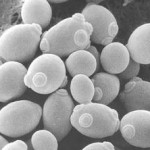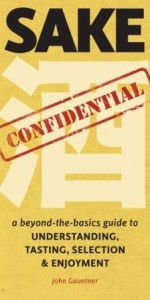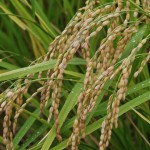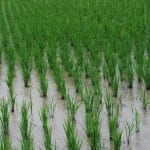 Sake yeast choices are an interesting – if frustrating – topic of study. I have covered them many times in the past in this newsletter, should you be interested in perusing the archives and even older back issues.
Sake yeast choices are an interesting – if frustrating – topic of study. I have covered them many times in the past in this newsletter, should you be interested in perusing the archives and even older back issues.
In short, yeast converts sugar to alcohol, and the choice of yeast leads to varying aromas – among other things, most notably acidity. There are many other things behind the choice of yeast, including robustness of fermentation, tolerance to alcohol, preferred temperature range and more.
Studying yeast types is interesting since they do have tendencies that we can learn to pick out. It is frustrating because there are many types, with countless variations and mutations, and they are blended all the time too. It all gets hard to follow! But if we can maintain our sense of humor, it continues to be worth it and fun.
These days there are many sources for yeast, but the classic source for the classic yeasts is the Nihon Jouzou Kyoukai, or the Brewing Society of Japan, a research organization that makes great yeast in pure form available to brewers.
 Back about 80 years ago when this organization was put together, they started to reproduce yeast that was known to be strong and predictable, and make it available to any brewer in the industry in little ampules. This helped ensure good sake, which led to good tax revenue. 😉
Back about 80 years ago when this organization was put together, they started to reproduce yeast that was known to be strong and predictable, and make it available to any brewer in the industry in little ampules. This helped ensure good sake, which led to good tax revenue. 😉
They started, naturally enough, with what they called Yeast Number 1. Next came Yeast Number 2, and so on. These days, they are up to Number 19, although there are a handful that do not follow this simple numbering convention. The yeasts distributed by this organization are collectively referred to as “Kyoukai Kobo,” or “Association Yeasts.”
But the first five fell out of comparative disuse, as did many of the more recently developed strains. In fact, there seems to have been shake-out amongst these yeasts, to the point that the only ones we see on a large scale are #6, #7, #9, #14, and #18-01. (Number 19-01 is only recently developed and has not had a chance to make its presence felt in the industry.) The others have all but disappeared. Not totally, mind you, but they are much less commonly seen.
Number 6 was developed at Aramasa in Akita, a brewery that is now making the most of that yeast and is massively popular, and deservedly so. Number 7 was developed at Masumi in Nagano, where it is also used with great success. However, ole’ 7 was erstwhile the most commonly used yeast for regular sake in the country. It still may be!
Number 9 was developed at Koro in Kumamoto, and while more ginjo-esque than its  predecessors, it now may be giving Number 7 a run for the money in how commonly it is used.
predecessors, it now may be giving Number 7 a run for the money in how commonly it is used.
Number 14 is more recently developed, in the last twenty years, and while popular in some regions – in particular those in the center of the country, close to Kanazawa in Ishikawa were it was developed – is not all that widely used. And newcomer (comparatively) Number 18-01 is growing in popularity for daiginjo sake, much as Number 9 did twenty or so years ago. (Note, the -01 just means it is a non-foaming version of the regular yeast. So Number 18-01 is really Number 18 that does not foam up so much. But this is a topic for another time!)
So, what’s the difference? What might you need to remember? In its simplest essence, bear this in mind: the higher the number, the fruiter the aromas, and the lower the acidity. So, Number 6 has a solid acidity and not much fruit. Number 1801 is much softer due to lower acidity, but much fruitier as well.
Is it really that simple? Of course not. Nothing is, especially in the sake world. But that general rule of thumb will serve you well, and you can stick it in your back pocket when you go out drinking sake.
Also, while not mentioned above, Yeast Number 10 is an interesting topic. It is basically a descendent of a family of yeast strains known as Meiri, developed by a company, Meiri Shurui, brewers of a sake called Fuku Shobun, in Ibaraki Prefecture. The straight Meiri yeasts are massively aromatic and popular, and as such, the ancestors, relatives and descendants (remember, yeast generations are very short!) of this yeast are much, much more common than the actual Number 10 itself. In fact, it is hard to define what a Number 10 tastes and smells like, in my experience anyway, since it so hard to come upon one that is pure anymore.
Of course, there is much tinkering going on. Many brewers had what was once a Number 9, as just one example, but now has mutated and changed to be something else. But they still might call it Number 9. Which is fine!
Also, there are countless other yeasts, developed by various research centers or naturally occurring in breweries. Tons of ‘em. Oodles and oodles of ‘em. And they are blended in myriad ways on top of all of that.
Hence aforementioned frustration, and aforementioned fun.
But when it comes to the Association Yeasts, the classics, which still arguably are used in most of the sake in the industry, we’re down to Numbers 6, 7, 9, 14 and 1801 as the main ones, i.e. “the usual suspects.” And remember the higher number, the more the fuit, and the lower the acidity. It’s a great rule of thumb that will only add to your enjoyment of sake.
~~~~~~~~~~~~~~~~~~~~~~~~~~~~~~~~~~~~~~~~~~~~~~~~~~~~~~~~~~~~
Be sure to look for my new book, Sake Confidential, available now at Barnes and Noble, Amazon, and the other usual suspects. Please check out the customer reviews on Amazon:
In over two-dozen short essays presented in a very informal and conversational tone, “the truth about sake” is revealed. The truth about junmai types versus non-junmai types, the truth about the impossibly detailed craft of sake brewing, the truth about temperature, premium types, aging, purity, pasteurization and regionality are all touched upon.
truth about sake” is revealed. The truth about junmai types versus non-junmai types, the truth about the impossibly detailed craft of sake brewing, the truth about temperature, premium types, aging, purity, pasteurization and regionality are all touched upon.
How the industry works, its challenges and strengths, what really creates sake flavors and aromas, specs you can safely ignore, and what hype you can safely avoid are all fair game. You’ll learn what goes into sake pricing, and how brewers get their rice. How to choose sake, and how to improve your tasting ability are also part of the fun. Suffice it to say that nowhere else is so much detailed information about the realities of the sake world assembled together into one place.
– See more at: http://sake-world.com/#sthash.5LOAMrBD.dpuf
– See more at: http://sake-world.com/#sthash.VDI391DO.dpuf







